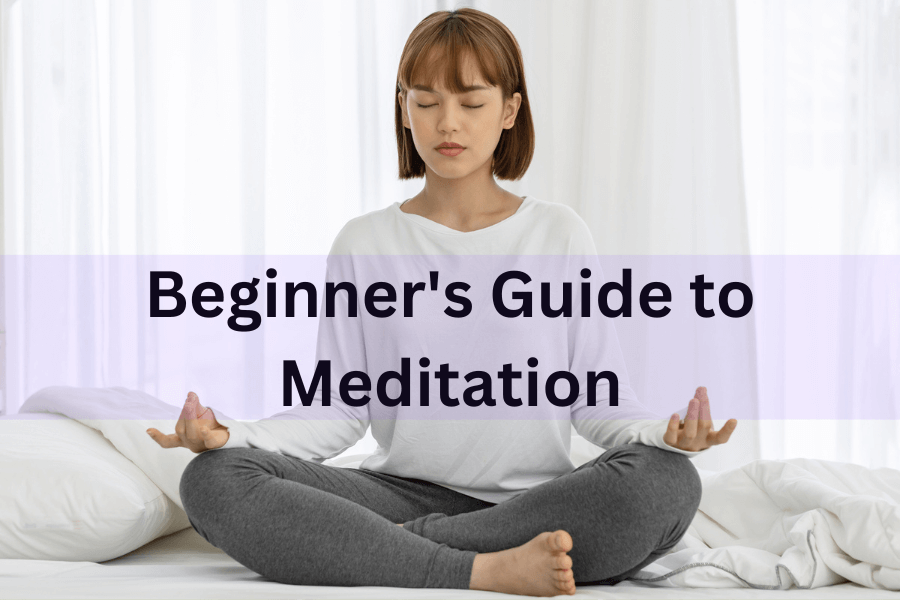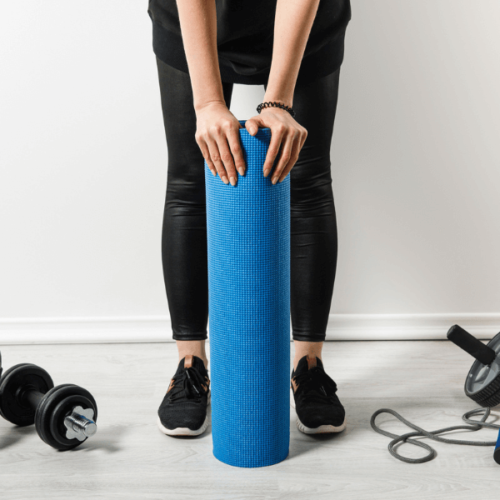Have you ever wanted to try meditation but don't know where to start? This Beginner's Guide to Meditation will help break it down into five very easy steps.

Key Takeaways
Start small - Begin with just 5 minutes of meditation per day and gradually increase from there. Finding guided meditations can be helpful for beginners.
Find a quiet space - Create a peaceful environment without distractions to make it easier to focus your mind. Use noise-cancelling headphones if needed.
Be consistent - Make meditation part of your daily routine at a set time. Don't get discouraged if your mind wanders at first, this takes practice. Stay committed.
What is Meditation?
Before jumping into our beginner tips, let's level-set on what meditation actually entails.
At its core, meditation is the practice of focusing your attention on the present moment while calmly acknowledging and letting go of any distracting thoughts or feelings.
Meditation is about gently guiding your awareness back to the here and now without getting frustrated or judging yourself when it inevitably drifts. The simple act of continually returning to the present has been scientifically shown to meaningfully reduce stress, improve emotional regulation, and enhance overall well-being.
Why is Meditation Important?
I don't think it's any secret that the benefits of meditation are significant. So many of us focus on eating well and getting enough exercise. However, I would argue that while meditation is something that most people recognize as important, the majority of people don't actively practice it.
In today's rushed, distraction-filled world, taking time for stillness and introspection can seem frivolous. However, building a meditation routine yields multifaceted benefits that enhance both mental health and daily functioning.
There are so many reasons as to why you should meditate and why it is important. Probably too many to list here. I would say that the top reasons meditation is important are as follows:
- Meditation improves your overall digestion (which is SUPER important for us at My So-Called Gut!)
Meditation allows you to find calm in an often chaotic world
Meditation brings your body back to its “center” and minimizes mind wandering.
Meditation allows you to constantly realign with those who are
Meditation allows the best version of “you” to come forth
Meditation improves your interactions with others and your overall well-being
- Meditation also enhances presence by training your mind to stay grounded in the moment rather than constantly projecting elsewhere. This allows you to move through life with greater intentionality.
Simply put, meditation facilitates healing and wholeness from the inside out.
5 Easy Tips in the Beginner's Guide to Meditation:
1) Start Small
The first (and probably most important) tip is to start small. And what I mean by this is to start with a basic meditation of a few minutes per day.
It's easy to get overzealous and commit to meditating for longer periods of 30-60 minutes daily right off the bat. However, longer sessions can seem daunting to total novices. This quickly leads to discouraged abandonment before experiencing any concrete benefits.
Instead, simply focus your mind for 5-10 minutes per day. Short sessions accommodate busy schedules while allowing your novice mind to acclimate without getting bored. There are plenty of guided meditation apps and videos out there for five minutes or less. YouTube offers thousands of these “five-minute meditations“, so find one that works best for you.
You will know when you are ready to move to a longer meditation, as your body or mind will eventually tell you. You will start to crave it, believe me. Perhaps the next logical step would be doing a 10-minute meditation. Start with meditating once a day and then maybe try it twice daily. When in doubt, always listen to your body.
Again, start slowly and see what works for you!
2) Find a Quiet Space
Finding a quiet meditation space is also really important, especially when you start your meditation practice.
Whether you are new to meditating or a seasoned pro, finding a quiet space to focus is extremely key. You will see that your mind likes to find as many excuses as it can to be distracted, which is why you don't want to add “noisy space” to its list of distractions.
Where I live (in San Francisco) space is a premium. And while I would absolutely love to set up a separate meditation room with candles, and a comfy pillow, and a large Buddha statue for inspiration (you get the idea), this is not my reality.
So, in order to carve a space out for my meditation (in a space-constrained apartment), it's rather simple.
I get up VERY early. That way I know that I can use a room where my husband, kid, and cat won't be constantly interrupting me. And believe me, I am so not a morning person.
I use my Apple AirPods Pro noise-canceling headphones, which I think are a must. I never appreciated this feature on my AirPods so much until I used it during meditations.
I use a yoga mat or meditation cushion to help me get into the best posture possible.
I use an eye pillow to help counter any possible light distraction.
And voila. These are pretty easy solutions for small, crowded spaces! For those of you with more space to spare, you can consider creating a personal meditation/yoga/personal space room that speaks just to you. Amazing.
3) Choose a Comfortable Posture
When beginning a meditation practice, one of the first things to determine is your physical posture. While elaborate lotus positions aren't mandatory, finding a comfortable seated position allows you to turn your focus inward without fidgeting or straining.
The most sustainable meditation pose involves sitting upright with your back straight on a cushion, pillow, or folded blanket. You can sit cross-legged, kneel, or even stand if needed.
The goal is to align your spine to allow free breathing techniques while keeping your head balanced above your torso. Relax your shoulders down and rest your hands in your lap or on your knees. Close your eyes, focus on your breath, and acknowledge any initial restlessness without judgment before redirecting attention to your breath.
Don't worry if some position fiddling occurs as your body adapts. Over time you’ll discover your optimal meditation sitting position allowing deeper stillness.
4) Use Resources for Beginner Meditators
As a novice, it can feel overwhelming trying to develop a meditation practice without guidance. Fortunately, more resources exist today supporting beginners than ever before.
Great digital options include specialized meditation apps, recorded guided meditations, and introductory meditation courses. Apps like Calm, Headspace, and Insight Timer provide programs that teach fundamental techniques through verbal walking-throughs. Their libraries also contain soundscapes, music, and timers facilitating home practice.
For human connection, local studios offer a multi-week beginner meditation course series led by a meditation teacher. These courses often are beneficial as they give clear instructions on meditation techniques.
Lastly, props such as weighted meditation cushions, eye pillows, and other useful starter tools can be purchased affordably online. Check out a variety of supportive resources to determine what combination best complements your learning style during these initial stages.
4) Be consistent
The last tip is to practice, practice, practice! And be consistent. As with anything, the more you do something the easier it becomes.
Do you know how people always say that the hardest part for most things you are reluctant to do (i.e- exercise, eating better, even some jobs) is showing up? Well, the same thing applies to meditation. You already won the moment you show up to practice!
Establishing a routine and consistency is the key to keeping your practice going, especially for routine-oriented people like me. Figure out what time works best for you…the mornings, the evenings, and mid-day, and commit to practicing at a similar time every single day.
I know, I know—with our busy lives it's tough to keep a consistency going. But trust me, all those amazing benefits you hear about from meditation come from repeat sessions working their magic
You will see that after you do this enough, it becomes part of your routine. And you will definitely start to miss it if you ever skip a day. It becomes THAT noticeable!
Types of Meditation
There are so many types of meditation that exist. I encourage you to keep trying different meditation techniques until you find one that works best for you. Here are four common types of Meditations that I recommend:
Mindfulness Meditation
This was the first type of meditation that I ever did and is a common one for beginners. It involves being fully present with your awareness and often involves closing your eyes and focusing on your breath. However, mindfulness meditation can also be done while walking, doing dishes, and even during a morning commute. The one key takeaway is to be aware of your thoughts but to not pass judgment on them.
Vipassana Meditation
This is a form of mindfulness meditation that comes from the teachings of Buddha. It involves seeing things how they actually are and focuses on the mind-body connection.
For those interested in learning more about Vipassana, you can sign up for a free, 10-day Vipassana retreat, which is more or less a silent meditation retreat. You spend 10 days in almost full silence, learning about this type of meditation and getting sufficient practice so that you can experience the benefits of Vipassana.
Transcendental Meditation (TM)
This meditation technique requires that you practice meditation twice daily for 20 minutes each session. With Transcendental Meditation you repeat a mantra over and over in your head versus following a meditation with guided words.
To officially learn Transcendental Meditation, you are required to have an official TM coach. And pay a rather substantial fee. That was always very off-putting to me and why I never pursued learning more about Transcendental Meditation. However, this is purely my opinion. I know people who have gone forward with the TM guide, have learned TM, and have sworn by this type of meditation.
Guided Meditation
This is the type of meditation that I am SUPER into at the moment. It involves listening to someone else “guide” you through meditation and often offers you different visualization techniques to help you focus. It took me years to find someone that I liked and that I could follow, so I encourage you to try a bunch of different ones and see what resonates with you.
Personally, I absolutely love Dr. Joe Dispenza, and encourage you to check out one of his guided meditations! However, this might not be your thing. In that case, other popular Guided Meditations are:
Popular Guided Meditations:
- Tara Brach
Headspace– requires payment, but they usually offer 1-2 weeks free
Gabby Bernstein
Calm – also requires payment, and they also offer a free-trial period.
Overcoming Common Meditation Challenges
Meditation is a wonderful way to calm your mind and improve your mental focus, but let’s face it: it’s not always easy. Whether you're a beginner or a seasoned meditator, some common challenges can get in the way of your practice.
Perhaps your mind wanders endlessly, or maybe you struggle to stay awake during longer sessions. But don't worry! It’s important to remember that there’s no right or wrong way to meditate, and these obstacles are completely normal.
With a little patience and perseverance, you can overcome them and enjoy all the benefits that meditation has to offer.
Summary
Now that you read the Beginner's Guide to Meditation, how do you feel? Are you ready to begin your meditation practice? Which meditation method will you choose?
The power and benefits of regular meditation are truly remarkable. From reducing stress and anxiety to improving sleep and overall well-being, incorporating meditation into your daily routine can truly be life-changing. And remember, it's never too late to start practicing.
Start small with just 5 minutes a day and gradually increase from there. Don't be afraid to use guided meditation or find a quiet space to make the experience more enjoyable and beneficial. But most importantly, be consistent and make meditation part of your daily routine.
And if your mind wanders during your practice, don't get discouraged. That's completely normal and takes time to overcome. Keep pushing through and stay committed to this powerful and transformative practice.
Trust me, your future self will thank you for it. So let's take action together. Carve out some time in your day for this simple yet powerful act of self-care and see the positive changes it brings into your life!
Namaste.
Frequently Asked Questions
How do I get started with meditation as a complete beginner?
Start by meditating for just 5-10 minutes per day using a guided meditation app or video. Find a quiet, distraction-free space and focus on your breathing while sitting comfortably. Don't worry if your mind wanders, just gently guide your attention back to your breath. Be consistent with your daily practice before gradually increasing your session length over time
What if I struggle with keeping my mind from wandering while meditating?
It's completely normal for your mind to wander, especially when you first start meditating. Don't get discouraged or judge yourself. Simply acknowledge when your thoughts drift, then softly redirect your awareness back to your chosen meditation anchor, whether it's your breath, a mantra, or something else. With regular practice, your ability to stay focused will improve.
How often should a beginner meditate each day?
Aim to start with just 5-10 minutes of meditation per day. This allows you to start small while still experiencing benefits without getting bored or overwhelmed as a novice. Once this feels sustainable, you can gradually build up to longer 20-30 minute sessions if desired. But remember, quality over quantity, even 5 minutes can make an impact.
What meditation posture should I use?
Find a comfortable seated position with your spine upright and shoulders relaxed. You can sit cross-legged, on a meditation cushion, kneel, or even stand. Close your eyes and settle into stillness by focusing inward on your breath. Don't fidget or strain. Over time you'll find your optimal posture for deeper focus.


